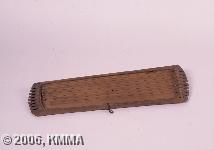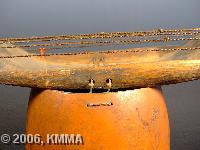


The organological term for this instrument, trough zither, takes its name from the form of the soundboard, which can be compared to a platter. Other languages have inspired other terms: French: cithare en forme de bouclier, and in English: trough zither.
The distribution of this instrument is limited to the Great Lakes region in the East of the Congo, Rwanda, Burundi and Tanzania. Like the board zither, the trough zither has its origins in South-East Asia.
The trough zither has a soundboard where the sides curl up in a slightly concave manner mimicking the shape of a platter. The dimensions vary from 75 to 115 cm in length and 25 to 30 cm in width. At the narrow ends, the trough’s edge is much deeper and with its 8 to 9 grooves is intended to hold the strings in place. Not all the grooves are designed to accommodate a string, the number of strings is always less than the number of grooves. Interestingly, the strings that are attached to the soundboard are not actually individual strings but one long, thin, braided, fibrous thread that is wound around and around the entire length of the soundboard into the available grooves. The end of the string is affixed to a perpendicular wooden block. To the west of Lake Tanganyika a supplementary calabash sound box is attached at the base of the trough zither to amplify the sound, since its range is very limited.
The range is generally on an anhemitonic pentatonic scale, which therefore implies that not all the 6 to 9 strings are used. The tuning is done by increasing or releasing the tension of the string to produce higher tones or lower tones respectively. Changing the pitch of a part of the string influences the pitch of the nearby tone because the string consists of one long piece.
The player sits down while playing and allows the trough zither to rest vertically on his lap. He holds the trough zither with the little finger of his left hand, while playing the top four strings with the other fingers of the left hand, and the four lower strings are played with the fingers of his right hand. The strings are played open with the fingertips and therefore produce a fixed tone on each string. A technique that is also used is to lightly touch the string in certain places and then pluck it to produce the upper harmonics. Rhythmically tapping the soundboard with the fingernails also gives additional sound. The playing position can also vary from musician to musician.
The function of this instrument and its music was previously intended for a limited public (the King and his entourage of nobility and women), but this instrument has now also found a place on the hilltops among the local population and there it is played to deliver stories of historical and/or local character. Generally the trough zither is played solo and the player sings his own songs, which deal with historical events, personal experiences or everyday stories.
This type of instrument is used in recordings of our sound archives made with the Congolese peoples mentioned hereafter where it appears with the following vernacular names:
Bafili (Bali, Kumu), Bapili (Mbuti), Enanga (Nande), Enzenze (Nande), Esanzo (Mongo), Inanga (Lega, Rundi), Inanga (Kinubi) (Hutu), Kingwandikila (Bembe), Langangu (Mbunda), Lulanga (Shi), Lunzenze (Luba-Kasai), Mafili (Bafili) (Pygmées), Nanga (Banyoro), Nedongu (Mangbetu), Ngombi (Segwirunibia) (Zande), Ngyela (Luba), Nzenze (Bira), Nzenze (zeze) (Lega), Seki (Mombutu), Zeze (Tembo)
Discography:
© KMMA